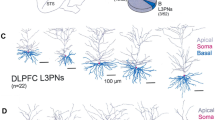Abstract
This paper outlines the functional capacities of a novel scheme for cognitive representation and computation, and it explores the possible implementation of this scheme in the massively parallel organization of the empirical brain. The suggestion is that the brain represents reality by means of positions in suitably constitutes phase spaces; and the brain performs computations on these representations by means of coordinate transformations from one phase space to another. This scheme may be implemented in the brain in two distinct forms: (1) as a “phase-space sandwich”, which may explain certain laminar structures, such as cerebral cortex and the superior colliculus; and (2) as a “neural matrix”, which may explain other structures, such as the beautifully orthogonal architecture of the cerebellum.
Similar content being viewed by others
References
Arbib, M. A. and Amari, S.: Unpublished, ‘Sensori-motor Transformations in the Brain, with a Critique of the Tensor Theory of the Cerebellum’, Technical report 84-01, Department of Computer and Information Science, University of Massachusetts at Amherst.
Cynader, M. and Berman, N.: 1972, ‘Receptive Field Organization of Monkey Superior Colliculus’, Journal of Neurophysiology 35, 187–201.
Goldberg, M. and Robinson, D. L.: 1978, ‘Visual System: Superior Colliculus’, in R. Masterson (ed.), Handbook of Behavioral Neurobiology, 1, Plenum, New York, pp. 119–64.
Gordon, B.: 1973, ‘Receptive Fields in Deep Layers of Cat Superior Colliculus’, Journal of Neurophysiology 36, 157–78.
Huerta, M. F. and Harting, J. K.: 1984, ‘Connectional Organization of the Superior Colliculus’, Trends in Neuroscience 7 (No. 8), 286–9.
Merzenich, M. and Kaas, J.: 1980, ‘Principles of Organization of Sensory-Perceptual Systems in Mammals’, Progress in Psychobiology and Physiological Psychology 9, 1–42.
Middlebrooks, J. C. et al.: 1984, Symposium: ‘Multimodal Maps in the Superior Colliculus’, Society for Neuroscience Abstracts 10 (Part 1), 268.
Pellionisz, A.: 1985, ‘Tensorial Aspects of the Multi-Dimensional Approach to the Vestibulo-Oculomotor Reflex’, to be published in A. Berthoz et al. (eds.), Reviews in Oculomotor Research, Elsevier, New York.
Pellionisz, A. and Llinas, R.: 1979, ‘Brain Modelling by Tensor Network Theory and Computer Simulation. The Cerebellum: Distributed Processor for Predictive Coordination’, Neuroscience 4, 323–48.
Pellionisz, A. and Llinas, R.: 1982, ‘Space-Time Representation in the Brain. The Cerebellum as a Predictive Space- Time Metric Tensor’, Neuroscience 7, 2949–70.
Robinson, D. A.: 1972, ‘Eye Movements Evoked by Collicular Stimulation in the Alert Monkey’, Vision Research 12, 1795–1808.
Schiller, P.: 1984, ‘The Superior Colliculus and Visual Function’, in I. Darian-Smith (ed.), Handbook of Physiology, Vol. III, pp. 457–504 (Chapter II), Maryland.
Schiller, P. and Stryker, M.: 1972, ‘Single-unit Recording and Stimulation in Superior Colliculus of the Alert Rhesus Monkey’, Journal of Neurophysiology 35, 915–24.
Stein, B. E.: 1984, ‘Development of the Superior Colliculus’, in W. M. Cowan (ed.), Annual Review of Neuroscience 7, 95–125.
Author information
Authors and Affiliations
Additional information
Special thanks to Patricia Churchland, who originally set me the problem of coordinating the schematic crab; and to Jeff Foss, whose scepticism concerning the computational power of neurally-embodied matrices provoked my construction of the phase-space sandwich. Thanks also to Larry Jordan, Bruce Bolster, Rodolfo Llinas, Andras Pellionisz, Francis Crick, and the Cognitive Mechanisms Group at the University of California, San Diego. This research was supported by a grant from the Institute for Advanced Study, by the Social Sciences and Humanities Research Council of Canada, grant no. 451-83-3050, by a sabbatical leave from the University of Manitoba, and by the University of California, San Diego.
Rights and permissions
About this article
Cite this article
Churchland, P.M. Cognitive neurobiology: a computational hypothesis for laminar cortex. Biol Philos 1, 25–51 (1986). https://doi.org/10.1007/BF00127088
Issue Date:
DOI: https://doi.org/10.1007/BF00127088




